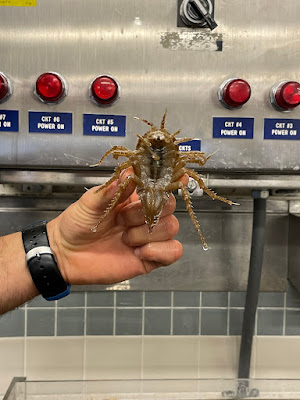The Crary science building has three floors (phases). The first floor is the chemists and lab supervisors, geoscience is on the second floor (that's me!), and the third floor is the aquarium.
Last Friday, one of the biologists gave me a tour of the aquarium. There are several giant pools and tanks that take in seawater (a pump goes from Crary, under the ice, and directly into the McMurdo Sound).
The science group (B-307) is based out of The University of Hawai'i Manoa in Honolulu. The scientists have been going out with the McMurdo divers to dive under the sea ice and collect different creatures.
 |
| A sea anemone. This one ate a sea spider a few weeks ago. |
The group is studying polar gigantism. This is the phenomenon where animals in the Southern Ocean around Antarctica have much larger body-sizes than their relatives in warmer waters across the globe. One of the theories for this is that there is more dissolved oxygen in the colder ocean waters, allowing creatures to grow to larger sizes.
 |
| A giant Antarctic isopod. Isopods (in warmer waters) typically only reach 0.5-1.5cm in length. This one is clearly much bigger! |
They are particularly interested in studying sea spiders. Sea spiders (or pycnogonids) are found all over the world, in both the cold Southern Ocean and in warmer waters. They very clearly follow the trend of polar gigantism, with tiny, 1 mm-sized spiders in more tropical climates, growing up to the huge 1-2 ft spiders found around Antarctica.
 |
| A tank of sea spiders! |
 |
| Small sea spiders exist in the Southern Ocean, too. These are about 1cm long. |
The group is studying how the physiology and biomechanics of Antarctic sea spiders compares to the smaller ones across the world. Aaron (the biologist who gave the tour) is studying the sea spiders' eyes specifically. He made a little blindfold for the sea spiders, and places them in water at different temperatures with different color lights and observes how they respond to their new environments.
 |
| This is Barney the sea spider (he's got barnacles on his legs, hence the name). |
 |
| Putting a sea spider back in the touch tank. |
The group is also studying how different creatures grow in warmer water temperatures. The sea creatures in the ocean around Antarctica have adapted to live in the below-freezing water over millions of years, and they are incredibly sensitive to even slightly warmer ocean temperatures. It's especially important to study how these animals are effected by temperature changes as the ocean warms due to climate change.
 |
| Here's Barney again. On the left, you can see a beautiful nudibrach (sea slug). |
 |
| Around the tube is a strand of nudibrach eggs. The biologists will cut a small section of the strand (1 inch contains hundreds of eggs) and hatch them in different temperature water tanks. |
Once again, they will use sea spiders for part of this study. Male sea spiders carry around the fertilized eggs for a few years until they hatch. The divers collect male sea spiders from the sea floor, take a sample of some of the eggs, and hatch the eggs in pools of water of varying temperature. The control water is at -1.8°C, the temperature of the sea water in McMurdo Sound.
 |
| Sea spider lifespans are not known. Aaron said that these sea spiders could be decades old, at least. |
It was really cool to walk around the aquarium and learn about the science the group is doing. It did also confirm that I am not a huge fan of sea creatures, and diving below the sea ice to the bottom of the ocean to collect these creepy crawlies would be my worst nightmare. I have huge respect for the scientists and divers who do this kind of work.
 |
| One last sea spider! |


Comments
-Mom